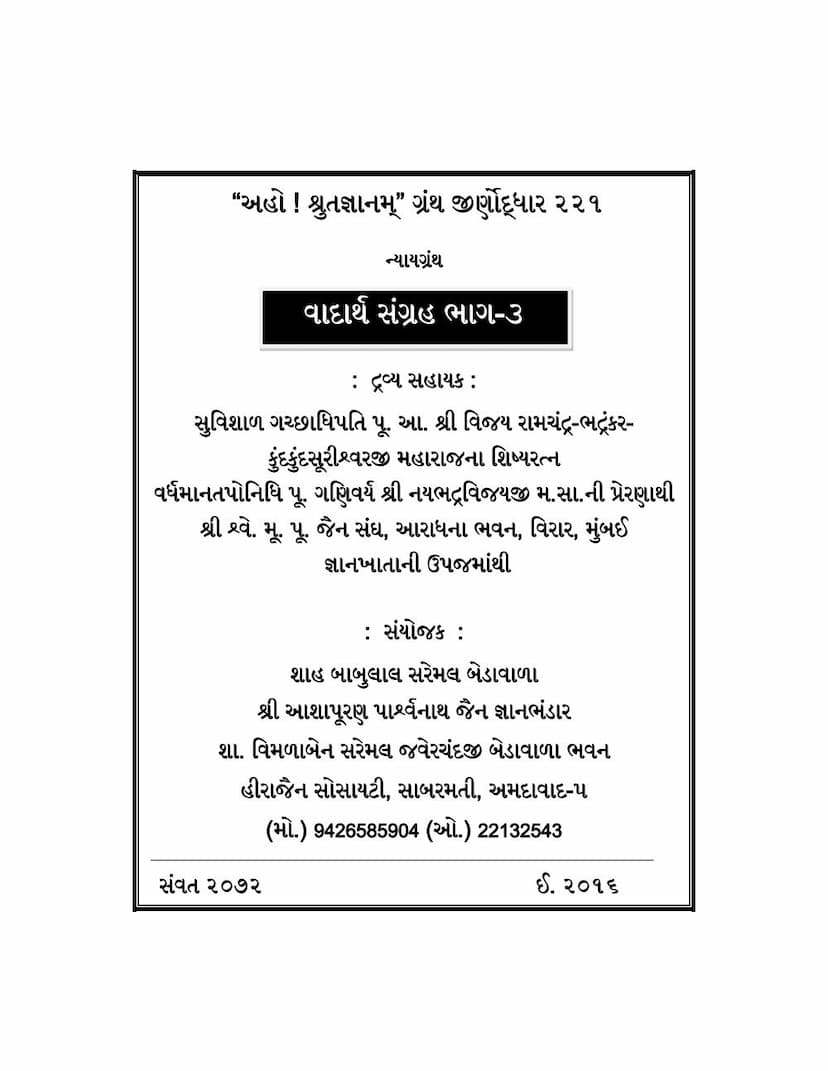Vadarth Sangraha Part 03 Vad Sudhakar Laghu Vibhaktyartha Nirnay Shabdabodh Prakashika
Added to library: September 2, 2025

Summary
Based on the provided pages, here's a summary of "Vadarth Sangraha Part 03: Vad Sudhakar, Laghu Vibhaktyartha Nirnay, Shabdabodh Prakashika" authored by Mahadev Gangadhar Bakre:
This book is the third part of the "Vadarth Sangraha" series, a collection of Jain philosophical and grammatical texts. The specific content of this volume focuses on three distinct treatises:
-
Vad Sudhakar (वादसुधाकर): This section, attributed to Shri Krishnaacharya, is a critical analysis of grammatical concepts, particularly concerning the meaning and function of finite verb endings (आख्यात - Akhyata). It delves into the debate between different schools of thought, primarily Tarka (logic) and Shabda (grammar), regarding the nature of the verb's meaning. Key discussions include:
- The power of the verb ending (शक्ति - Shakti): Whether it resides in the action itself (कृति - Kriti) or in the agent (कर्ता - Karta).
- The role of indication (लक्षणा - Lakshana): When direct meaning is not possible, how indication is employed and its implications.
- The relationship between verb endings and tense/aspect (वर्तमानत्व - Vartamanatva, etc.): How these are conveyed and their interaction with the action.
- The implications of the verb's meaning for grammatical rules: The text explores how different interpretations of the verb's function affect the application of Sanskrit grammatical rules, such as the rule for "Karma-vat-karma-na" (कर्मवत्कर्मणा तुल्यक्रियः).
- The Tarka perspective vs. the Shabda perspective: The work highlights the differing viewpoints of logicians (Tarkikas) and grammarians (Shabdikas) on these matters.
-
Laghu Vibhaktyartha Nirnay (लघुविभक्त्यर्थनिर्णय): This section, authored by Shri Krishna Bhatta (also referred to as Maunishri Krishna Bhatta), meticulously examines the meanings of case endings (सुबन्तविभक्ति - Subanta Vibhakti) in Sanskrit grammar. It provides a detailed explanation of the function and significance of each case, from the first (Prathama) to the seventh (Saptami). The analysis often engages with different interpretations offered by various schools of thought, particularly the Grammarians (Shabdika) and Logicians (Naiyayikas). Key aspects covered include:
- The definition and function of case endings: What constitutes a case ending and its role in conveying meaning.
- The nature of grammatical case (कारक - Karaka): The text discusses whether case is determined by grammatical rules or by the intended meaning (विवक्षा - Vivaksha).
- The precise meaning of each case: This includes detailed explanations for Prathama (nominative), Dvitiya (accusative), Tritiya (instrumental), Chaturthi (dative), Panchami (ablative), Shashti (genitive), and Saptami (locative), often addressing nuances and exceptions.
- Discussions on various rules and their interpretations: The author frequently refers to and analyzes grammatical aphorisms (सूत्र - Sutra) and their commentaries.
-
Shabdabodh Prakashika (शाब्दबोधप्रकाशिका): This part, written by Ramkishore, focuses on "Shabdabodha" (शाब्दबोध), which refers to the process of semantic comprehension or the mental representation of meaning derived from words. It aims to clarify how meaning is understood and constructed in the mind through language. Key themes explored are:
- The primacy of the verb (क्रिया - Kriya) in semantic understanding: The text argues that the verb is the central element, and other words in a sentence relate to it.
- The limitations of interpretations that prioritize nominals (नामार्थ - Namartha): It refutes the idea that the primary meaning resides in nouns, using logical arguments and examples to support the verb-centric view.
- The role of prefixes (उपसर्ग - Upasarga) and particles (निपात - Nipat): The text discusses whether these elements are merely indicative (द्योतक - Dyotaka) or actually convey meaning (वाचक - Vachaka), favoring the indicative role for many of them.
- The nature of understanding complex sentences: It delves into how the meaning of sentences is synthesized, considering the interplay of different word classes.
- The philosophical underpinnings of language and meaning: The text touches upon the metaphysical aspects of language and how meaning is ultimately derived and understood.
Overall Significance:
"Vadarth Sangraha Part 03" appears to be a scholarly work aimed at understanding the intricacies of Sanskrit grammar and philosophy as applied to Jain thought, particularly in the areas of verb semantics and case meanings. The detailed analysis and engagement with various interpretive traditions suggest a deep dive into the linguistic and logical foundations of philosophical discourse. The publication is part of a larger project to preserve and disseminate ancient Jain knowledge, as indicated by the "Granth Jiirnoddhar" (Library Restoration) initiatives mentioned.